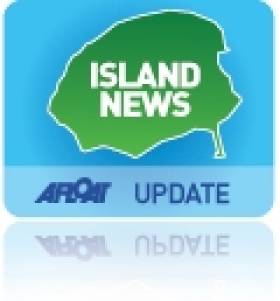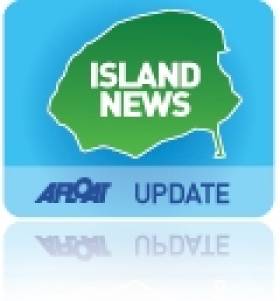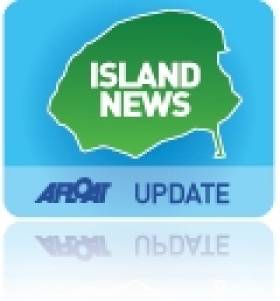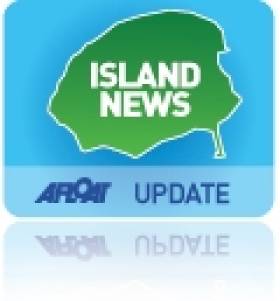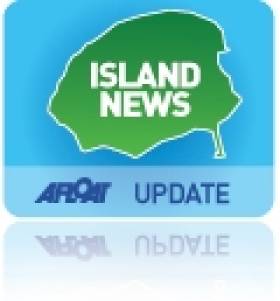Displaying items by tag: Island News
#ISLAND NEWS - Champion cliff diver Orlando Duque paid a visit to Cong in Co Mayo recently to give a taster of what we can expect when Red Bull Cliff Diving comes to the Aran Islands this August.
As the video above shows, the nine-time World Champion from Colombia dived from the unusual platform of a helicopter hovering high over the water at Ashford Castle.
But it will be just his fellow competitors, the rocks and the waves to contend with at the Serpent's Lair in Inis Mór on 3-4 August at the fourth stop of the 2012 World Series, as previously reported on Afloat.ie.
“The Serpent’s Lair is one of those places you only hear stories about,” said Duque ahead of the first ever World Series in 2009. “Finding this place and being able to dive there was one of the highlights of my career."
Busy Day for Aran Islands Capital
#ARAN ISLANDS CRUISE CALL – Two vessels, a cruiseship and a lighthouse tender are today off Kilronan, the capital of Inishmore, the largest of the Aran Islands, writes Jehan Ashmore.
The ships are the 114 passenger cruiseship Island Sky (1992/4,200grt) operated by Noble Caledonia which called this morning having originally departed in Portsmouth and the Commissioners of Irish Lights tender ILV Granuaile (2000/2,365grt) which is based in her homeport of Dun Laoghaire.
Kilronan will be a hive of activity, not just those passengers tendered ashore from the cruiseship but also tourists arriving by frequent ferry services from Rossaveal, Co. Galway and Doolin in Co. Clare. The majority of sightseers will no doubt be heading for the main attraction of Dun Aengus fort on the far side of the island which is reached by shuttle buses and the traditional pony and trap.
The Island Sky's sister the Caledonian Sky which too is operated by the same company made yesterday an anchorage call off Sneem Co. Kerry. It is along the western seaboard that such smallships are attracting a niche market. In addition it is in these same waters is where ILV Granuaile is more often to be found working during the summer months as the weather is more favourable to carry out aids to navigation duties.
Unlike the cruiseship, the lighthouse tender does not actually anchor. Instead she can maintain a constant position using dynamic positioning (DP) which uses satellite technology to adjust the vessels manouvering systems to precise pin-point accuracy.
#ISLAND NEWS - The latest Marine Notice from the Department of Transport, Tourism and Sport (DTTAS) outlines the reinstatement of passage for boats through Achill Sound in Co Mayo.
Passage will be subject to the following procedures that Mayo County Council have put in place in relation to the opening of the Achill Sound Bridge:
Mayo County Council will require a minimum of two working days’ notice to open the bridge (contact [email protected] or call 097 81004 between 9am-1pm and 2pm-5pm Monday to Friday to give the required notice).
Opening will be dependent on weather conditions.
Opening shall be at high water and between the hours of 9am and 3.30pm (Monday-Thursday) and 9am-2.30pm on Friday. Opening outside these hours and on public holidays will only take place in exceptional circumstances.
As a result of the changes outlined in Marine Notice No 24 of 2012, the directions of Marine Notice No 36 of 2010 are now superseded.
Red Bull Cliff Diving World Series Comes to Ireland
#ISLAND NEWS - Red Bull Cliff Diving will come to Ireland's west coast for the fourth stop of the 2012 World Series on 3-4 August.
The competition will see the world’s best cliff divers converge on the biggest of the three Aran Islands for the season’s halfway stage.
A ferry ride from Galway, Inis Mór is home to the Serpent’s Lair – ‘Poll na Peist’ in Irish – a natural formation that fishermen call a ‘blowhole’.
"What makes the Serpent’s Lair special," says Red Bull, "is that it’s a near-perfect rectangle, its inexplicable shape ensconced in Gaelic legend."
“The Serpent’s Lair is one of those places you only hear stories about,” said Colombian cliff diver Orlando Duque ahead of the first ever World Series in 2009. “Finding this place and being able to dive there was one of the highlights of my career."
Orlando’s hopes to return will surely be answered during the first weekend of August as he sets his sights on securing the 2012 title.
Other stops in this year's World Series include France on 22-23 June, Norway on 6-7 July, the Azores on 20-21 July, the USA on 24-25 August, the UK on 7-8 September and Oman on 27-28 September.
Aran Islands are 'the Stepping Stones to the Atlantic'
#ISLAND NEWS - Writing in the Boston Globe recently, Cork native Thomas Breathnach extols the virtues of the Aran Islands as "a bastion of native culture".
"The country’s roughest seas and 1,000 miles of ancient stone walls have successfully preserved Celtic tradition within their spellbinding shores," he writes of those western isles referred to as "the stepping stones to the Atlantic".
Traversing the archipelago by foot, bicycle and plane, Breathnach sees the sights and greets the characters that make the Aran Islands such an attraction for tourists the world over.
The Boston Globe has much more on the story HERE.
Wogan's Visit to Cape Clear Island
#ISLANDS - Cape Clear Island's most well-known couple may get even wider attention now that they're featured in Terry Wogan's new book on Ireland.
Micheál and Sile Ó Ceadagáin – who were the focus of TG4 programme Mí na Meala – are two of the many characters included in Wogan's Ireland, the book accompanying the legendary broadcaster's recent TV series.
According to the blog of the Cape Clear ferry service Cailín Óir: "The photographs [included] are stunning, including those of Cléire and Fastnet, to where Terry enjoyed an idyllic summer’s outing with Micheál on his boat The Gaisceannán.
"Micheál and Sheila are a hospitable couple which extends to the boat and Micheal's famous teas served at sea have pleased many, including the indefatigable Terry."
Wogan's Ireland is packed with photos and stories of Terry's whistle-stop tour of the country's 'coastal fringe', laced with his self-deprecating wit. The book is available online for as little as €10.
New 2012 Timetable for Cape Clear Ferry
#ISLANDS -The Cape Clear Ferry which operates the service between the Wst Cork island and Baltimore, has outlined revisions to sailing schedules for this year. The proposed changes follow a consultation process held with the islanders, as previously reported on Afloat.ie
The changes to sailings during the months of May, June and September and also to schedules between 1st April-30th December are available to view by clicking HERE.
In addition a table showing the minimum frequency of daily return sailings are also outlined.
Cape Clear Islanders to Discuss Ferry Service
#ISLANDS – A public meeting between the islanders of Cape Clear and the Cailín Óir Ferry Service will be held on Saturday 28th January, so to discuss proposed changes to the ferry schedule in 2012.
The meeting is to be held in the local community hall, where other matters in relation to the year round service between Baltimore and the Gaeltacht speaking island will be aired. The island which is three miles long and one and half mile wide has a resident population of 130 inhabitants, which swells significantly during the summer months.
In March last year a new main ferry was purchased the Island Princess and renamed Dún an Óir II. She operates a schedule that varies between one and up to three round trips daily, subject to the day and time of the year, to view the current winter timetable click HERE.
Lecture: 'Searching for Saints-Skelligs to Iceland'
#LECTURES-Paddy Barry will be presenting "Searching for Saints –Skelligs to Iceland" the second of five Winter talks in a programme organised by the Dublin Bay Old Gaffers Association (DBOGA). The talk takes place this Tuesday evening at 8pm in the Poolbeg Yacht and Boat Club, Ringsend in Dublin Port.
Those wishing to attend may wish to arrive a bit earlier so to avail of the PYBC's clubhouse facilities, which overlooks its marina in the centre of the port, opposite Alexandra Basin.
The venue is located on the South Bank, Pigeon House Road, Ringsend which can be accessed from the Sean Moore Road that connects the Merrion Strand Road (from the south) and the East-Link Toll Bridge (from the north).
For further information on the DBOGA lectures and more click HERE. In addition information about the PYBC Tel: (01) 668 9983 or logon to www.poolbegmarina.ie/
Three’s A Crowd as Naval, Research and Cargo Ships Dock In Galway
Also sharing the basin but located closer to the dock gates was Arklow Shipping Ltd's Dutch registered dry-cargo vessel Arklow Surf (2000/2,316grt). The dock is capable of handling more vessels simultaneously and of course used as a host-port of the high-profile Volvo Ocean Race which is due to return next year.
Galway and neighbouring Limerick City with its Ted Russell Dock, are the only dock-gate accessed ports on the island of Ireland. In the case of Galway there is an exception as freight operations are also available from an outer pier on the seaward side of Dún Aengus Dock though only for domestic purposes. From this pier the dedicated Aran Islands freight service is operated by Lasta Mara TEO's Blath na Mara (1983/330grt). As for Limerick, vessels can also berth outside the dock but they tend to be small port-work related craft that use the outer berth on the Shannon Estuary.
The Galway Harbour Company in recent years have proposed plans for a new outer port, to be built in four stages with a completion date set for 2017. This would enable larger deeper drafted vessels such as tankers and cruiseships to dock in the new port. In the meantime cruiseships anchor off Mutton Island. In addition a freight rail-link, berthing for an inshore fishing fleet and a 216 berth marina are proposed.
To read more about the port proposals visit http://www.galwayharbour.com/news.php?id=11and for aerial visual impressions click HERE.
- River Shannon
- Marine Institute
- naval service
- Ports and Shipping
- Arklow Shipping Ltd
- Ports and Shipping News
- Aran Islands
- Island News
- Galway Bay News
- Marine Science News
- Dun Aengus Dock
- Galway Harbour Company
- Cruise Liner news
- Cruise ships
- Galway Harbour and Bay news
- Ted Russell Dock
- Marine Instistute Research vessels
- Lasta Mara TEO



























